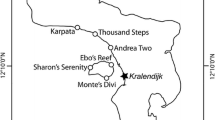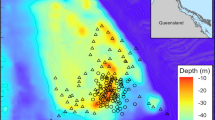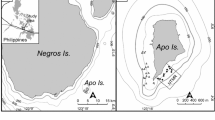Abstract
Increasing interest for recreational SCUBA diving worldwide is raising the concern about its potential effects on marine ecosystems. Available literature is still much focused either on impacts on coral reefs of tropical regions or on diver’s behaviour underwater. In this study we analysed, through photo-quadrats, the benthic community composition in a section of a decommissioned Portuguese navy ship that was sunk for touristic purposes. The ship broke down and became separated in two sections enabling a Control versus Impact sampling design, as one section is less attractive for diving. Gorgonians (mainly belonging to the species Leptogorgia sarmentosa and Eunicella verrucosa) were the taxa more negatively affected in the dived ship section, with smaller coverage and size. More resilient species such as the acorn barnacle Amphibalanus amphitrite were positively correlated with the Impact samples. In the case of the study area, according to the available data, 70% or more of the total amount of dives are now on the sunken ships. From these results, lessons can be taken to apply on natural reefs and related management plans.




Similar content being viewed by others
References
Abidin SZ, Mohamed B (2014) A review of SCUBA diving impacts and implication for coral reefs conservation and tourism management. SHS Web of Conf 12:01093. https://doi.org/10.1051/shsconf/20141201093
Barker NH, Roberts CM (2004) Scuba diver behaviour and the management of diving impacts on coral reefs. Biol Conserv 120(4):481–489. https://doi.org/10.1016/j.biocon.2004.03.021
Barnes M (1999) The mortality of intertidal cirripedes. Oceanogr Mar Biol Annu Rev 37:153–244
Baynes TW, Szmant AM (1989) Effect of current on the sessile benthic community structure of an artificial reef. Bull Mar Sci 44(2):545–566
Bell J, Turner JR (2000) Factors influencing the density and morphometrics of the cup coral Caryophyllia smithii in Lough Hyne. J Mar Biol Ass UK 80:437–441. https://doi.org/10.1017/S0025315400002137
Bohnsack JA, Sutherland DL (1985) Artificial reef research: A review with recommendations for future priorities. Bull Mar Sci 37:11–39
Chadwick-Furman NE (1997) Effects of SCUBA diving on coral reef invertebrates in the U.S. Virgin Islands: implications for the management of diving tourism. In: den Hartog JC (ed) Proceedings of the sixth international conference on coelenterate biology. Nationaal Naturhistorisch Museum, The Netherlands, pp 91–100
Cocito S, Bedulli D, Sgorbini S (2002) Distribution patterns of the sublittoral epibenthic assemblages on a rocky shoal in the Ligurian Sea (NW Mediterranean). Sci Mar 66(2):175–181. https://doi.org/10.3989/scimar.2002.66n2175
Coma R, Pola E, Ribes M, Zabala M (2004) Long-term assessment of temperate octocoral mortality patterns, protected vs. unprotected areas. Ecol Appl 14(5):1466–1478. https://doi.org/10.1890/03-5176
Cúrdia J, Monteiro P, Afonso CM, Santos MN, Cunha MR, Gonçalves JM (2013) Spatial and depth-associated distribution patterns of shallow gorgonians in the Algarve coast (Portugal, NE Atlantic). Helgol Mar Res 67:521–534. https://doi.org/10.1007/s10152-012-0340-1
Garrabou J, Sala E, Arcas A, Zabala M (1998) The impact of diving on rocky sublittoral communities: A case study of a bryozoan population. Conserv Biol 12(2):302–312. https://doi.org/10.1111/j.1523-1739.1998.96417.x
Goodwin C, Rodolfo-Metalpa R, Picton B, Hall-Spencer JM (2014) Effects of ocean acidification on sponge communities. Mar Ecol 35:41–49. https://doi.org/10.1111/maec.12093
Hardiman N, Burgin S (2010) Recreational impacts on the fauna of Australian coastal marine ecosystems. J Environ Manag 91(11):2096–2108. https://doi.org/10.1016/j.jenvman.2010.06.012
Hasler H, Ott JA (2008) Diving down the reefs? Intensive diving tourism threatens the reefs of the northern Red Sea. Mar Pollut Bull 56:1788–1794. https://doi.org/10.1016/j.marpolbul.2008.06.002
Hawkins JP, Roberts CM (1992) Effects of recreational SCUBA diving on fore-reef slope communities of coral reefs. Biol Conserv 62(3):171–178. https://doi.org/10.1016/0006-3207(92)91045-T
Hawkins JP, Roberts CM, Hof TV, De Meyer K, Tratalos J, Aldam C (1999) Effects of recreational scuba diving on Caribbean coral and fish communities. Conserv Biol 13(4):888–897. https://doi.org/10.1046/j.1523-1739.1999.97447.x
Hiscock K, Howlett RM (1976) The ecology of Caryophyllia smithi Strokes and Broderip on South-western coasts of the British Isles. In: Drew EA (ed) Underwater Research. Academic Press, New York, 438 pp
Hiscock K, Sharrock S, Highfield J, Snelling D (2010) Colonization of an artificial reef in south-west England - ex-HMS ‘Scylla’. J Mar Biol Ass UK 90:69–94. https://doi.org/10.1017/S0025315409991457
Leeworthy VR, Maher T, Stone EA (2006) Can artificial reefs alter user pressure on adjacent natural reefs. Bull Mar Sci 78(1):29–37
Linares C, Coma R, Mariani S, Díaz D, Hereu B, Zabala M (2008) Early life history of the Mediterranean gorgonian Paramuricea clavata: implications for population dynamics. Invertebr Biol 127(1):1–11. https://doi.org/10.1111/j.1744-7410.2007.00109.x
Lloret J, Marín A, Marín-Guirao L, Carreño MF (2006) An alternative approach for managing scuba diving in small marine protected areas. Aquatic Conserv: Mar Freshw Ecosyst 16:579–591. https://doi.org/10.1002/aqc.734
Luna B, Pérez CV, Sánchez-Lizaso JL (2009) Benthic impacts of recreational divers in a Mediterranean Marine Protected Area. ICES J Mar Sci 66(3):517–523. https://doi.org/10.1093/icesjms/fsp020
Lyons PJ, Arboleda E, Benkwitt CE, Davis B, Gleason M, Howe C, Mathe J, Middleton J, Sikowitz N, Untersteggaber L, Villalobos S (2015) The effect of recreational SCUBA divers on the structural complexity and benthic assemblage of a Caribbean coral reef. Biodivers Conserv 24(14):3491–3504. https://doi.org/10.1007/s10531-015-1009-2
Martins R, Azevedo MR, Mamede R, Sousa B, Freitas R, Rocha F, Quintino V, Rodrigues AM (2012) Sedimentary and geochemical characterization and provenance of the Portuguese continental shelf soft-bottom sediments. J Mar Syst 91:41–52. https://doi.org/10.1016/j.jmarsys.2011.09.011
Moura A, Boaventura D, Cúrdia J, Santos MN, Monteiro CC (2006) Biomass production of early macrobenthic communities at the Faro/Ancão artificial reef (Portugal): effect of depth and reef layer. Bull Mar Sci 78:83–92
Neil D (1990) Potential for coral stress due to sediment resuspension and deposition by reef walkers. Biol Conserv 51:221–227. https://doi.org/10.1016/0006-3207(90)90127-B
Nyström M, Folke C, Moberg F (2000) Coral reef disturbance and resilience in a human-dominated environment. Trends Ecol & Evol 15(10):413–417. https://doi.org/10.1016/S0169-5347(00)01948-0
Pech D, Condal AR, Bourget E, Ardisson P (2004) Abundance estimation of rocky shore invertebrates at small spatial scale by high-resolution digital photography and digital image analysis. J Exp Mar Biol Ecol 299:185–199. https://doi.org/10.1016/j.jembe.2003.08.017
Preskitt LB, Vroom PS, Smith CM (2004) A rapid ecological assessment (REA) quantitative survey method for benthic algae using photoquadrats with scuba. Pac Sci 58(2):201–209
Rouphael T, Inglis G (1995) The effects of qualified recreational SCUBA divers on coral reefs. Technical Report No. 4. CRC Reef Research Centre, Townsville 39 pp
Stolk P, Markwell K, Jenkins JM (2007) Artificial reefs as recreational scuba diving resources: A critical review of research. J Sustain Tour 15(4):331–350. https://doi.org/10.2167/jost651.0
Tratalos JA, Austin TJ (2001) Impacts of recreational SCUBA diving on coral communities of the Caribbean island of Grand Cayman. Biol Conserv 102:67–75. https://doi.org/10.1016/S0006-3207(01)00085-4
Wendt PH, Knott DM, Van Dolah RF (1989) Community structure of the sessile biota on five artificial reefs of different ages. Bull Mar Sci 44(3):1106–1122
Wilhelmsson D, Öhman MC, Ståhl H, Shlesinger Y (1998) Artificial reefs and dive tourism in Eilat, Israel. Ambio 27(8):764–766
Zakai D, Chadwick-Furman NE (2002) Impacts of intensive recreational diving on reef corals at Eilat, northern Red Sea. Biol Conserv 105(2):179–187. https://doi.org/10.1016/S0006-3207(01)00181-1
Acknowledgements
This project was funded by Associação para a promoção e desenvolvimento do turismo subaquático (Musubmar) and G.C. had the support of Fundação para a Ciência e Tecnologia (FCT), through the strategic project UID/MAR/04292/2013 granted to MARE. The authors would also like to acknowledge the assistance from Subnauta diving center in logistics regarding data collection as in providing valuable information about the number of dives in the study sites and adjacent diving spots.
Author information
Authors and Affiliations
Corresponding author
Ethics declarations
Conflict of interest
The authors declare that they have no conflict of interest.
Ethical approval
This article does not contain any studies with animals performed by any of the authors. Only non-invasive methods were applied to acquire the biological data.
Sampling and field studies
All necessary permits for sampling and observational field studies have been obtained by the authors from the competent authorities and are mentioned in the acknowledgements, if applicable.
Rights and permissions
About this article
Cite this article
Encarnação, J., Calado, G. Effects of recreational diving on early colonization stages of an artificial reef in North-East Atlantic. J Coast Conserv 22, 1209–1216 (2018). https://doi.org/10.1007/s11852-018-0630-0
Received:
Revised:
Accepted:
Published:
Issue Date:
DOI: https://doi.org/10.1007/s11852-018-0630-0




